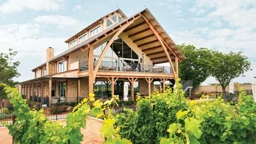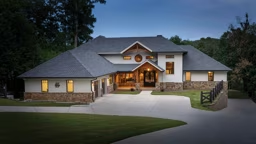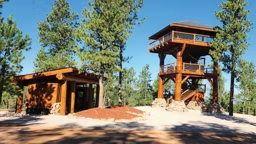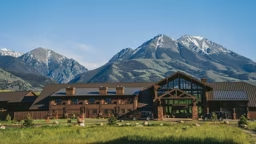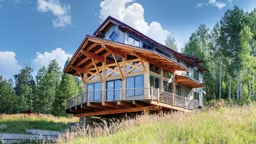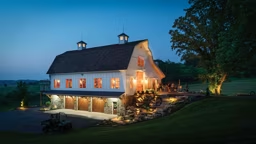Barns have come a long way. Historically speaking, these buildings have been utterly utilitarian and bare bones, offering just enough space and structure to keep animals safe from weather and predators or to store the equipment necessary to work the family farm. Usually, any “style” was limited to an exterior paint color, or, if you got really fancy, a cupola topped with a weather vane.
Times have changed, however.
Animal lovers — particularly horse enthusiasts — want to keep their furry friends in the lifestyle to which they, themselves, have become accustomed.
But you don’t have to raise a herd to enjoy the creature comforts a barn-style home can bring. We’ve round up a few barn-style design aficionados who have taken the reins on this growing residential trend to steer us in the right direction. Whether the structure will house man, beast or machine (or all three), we look at several different approaches to incorporating a barn-style abode in your home plans.
The Latest in Barn-Style Design
We caught up with Casey Rogness, senior designer at DC Structures, an Oregon-based firm specializing in barn-style buildings from working barns to party barns to homes. After eight years of designing buildings for clients, he has his finger on the pulse of this versatile style.
Donna Peak: What are your barn-style home clients requesting, and what trends are you seeing?
Casey Rogness: Since the beginning of the pandemic, we’ve seen quite an increase in interest in barn-style homes. They’re such multi-use structures. A lot of people put garages or hobby shops on the ground level — some even keep animals, like horses, down there — with living quarters on the level above. We’ve also had clients who use the lower level as event space, complete with commercial kitchens, that they rent out while they live upstairs. This kind of arrangement is also a good apartment for an animal caretaker, ranch hands, grown children or guests. It’s exciting knowing our structures get used in such a variety of ways.
DP: In many of the designs DC Structures drafts, the bottom level is utilitarian or offers secondary spaces like bedrooms or game rooms, while the top level contains the primary, day-to-day living area. Is the idea of a “reverse floor plan” popular with buyers?
CR: Yes, this is definitely a trend. This has been our style from the beginning of DC Structures, and it’s just continuing to grow. We have projects from Hawaii to Texas, and the style just works in every geographic region. It’s access to the owner’s passion, whether it’s animals or entertaining, that’s driving design.
DP: Are there any special soundproofing or odor containment measures that you need to take when sharing a building with animals or heavy-duty equipment?
CR: There aren’t really any restrictions in terms of design, but there are a few code restrictions, especially pertaining to separation between a barn and a living space. You need to have fire-rated walls and doors, and the second story has to have a direct, independent exit to the exterior. In the event of a fire, you have to have an egress from the top level via an external staircase. A lot of people don’t know the codes and restrictions that apply to this kind of design, and that’s where our experience comes in. We steer the clients in the right direction to make sure they get everything they need.
When it comes to containing any smells, most people who want to live in the same building as their horses or other animals understand that their aroma comes with the territory. However, there are some things we can do to keep odors as contained as possible, like install a second door and vestibule, kind of like the air-lock entry you’d find at a home-improvement store or department store, that will separate the barn from the living space and provide a buffer.
DP: Barn-style houses have been around for a while. Have trends changed much over the past five years?
CR: A lot of the recent changes have come more in the way of energy code updates than to design. There are more things we have to consider in terms of engineering, insulation and mechanicals. Plus, each jurisdiction has its own rules and regulations that we have to follow. For instance, some areas may have a restriction on how tall a structure can be (a 35-foot limit is common), so we have to take that into account while drafting the kind of house our client wants. But in regard to layout, not much has really changed — which is kind of an advantage because if you like this style, it’s pretty timeless. You don’t have to worry about it feeling dated. Plans that our company designed and built 10 years ago still hold up today.
DP: What advice would you give someone who’s considering living in a barn-style home?
CR: One thing to consider — and this isn’t limited to barn homes — is stairs. Stairs always take up more space than people realize. Trying to get a staircase to work with both the lower-level stable or shop, as well as the upper-level living space can be a challenge. It’s one of the first points we bring up in our kick-off meeting with a new client. In fact, many people install an elevator in addition to stairs. With the main living on the upper level, clients want to ensure they have access if mobility becomes an issue, especially if this is going to be their forever home. Residential elevators have really come down in price; they’re not as much of a luxury item as they were in the past. So we are incorporating elevator shafts in a lot of our plans now.
DP: One of the barn-style plans you feature on your website, the “Port Angeles” barn home, utilizes the bottom level as an RV garage, which is a clever design feature, and includes the elevator you just mentioned. What goes into creating a customized plan like that?
CR: This plan brings its own restrictions to it. For example, people who own RVs don’t really want to have to back them out of a garage; they prefer to pull through. In addition to specifying 14-foot-tall garage doors, we needed to design one on each end of the home. Of course, this extra height raises the upstairs living level another 18 to 24 inches, which can get into the issue of height restrictions. So, we need to get creative to make sure the clients get what they want while staying within code.
For example, we have a project in Oregon that uses the RV design. The house has a lot of restrictions because it’s right on the river and a few other setbacks that we had to deal with, so we shifted the RV storage out a bit so that it sat under a shed-roof side of the home, which enabled us to lower the overall height of the structure.
Horse owners, in particular, have their own way of living and the way they care for and interact with their horses. We rely on them to drive their layout and what they need in the barn.
We never feel stuck in a box of how our houses are supposed to be. We work with each client and the location of the home to make things work and meet the client’s needs. We never build the same home twice.
See also: For One Family, a Barn Home in Nebraska Is a Respite From Busy City Life
5 Tips to Design Success
When it comes to timber-barn living, Timberlyne (the new combined home of Sand Creek Post & Beam and Texas Timber Frames), executive director of marketing Cody Wortmann is an expert. His company has helped hundreds of families realize their dreams to live in a charming, modern, barn-style home. He shares his five secrets to success.
1. Adaptable Styles. Consider the available barn styles not only for their exterior appeal, but also for their interior function. Gambrels have an iconic countryside curb appeal but also allow for usable loft space. Raised center style barn homes are perfect for transom windows, flooding your great room with natural light.
2. Loft or No Loft. While a lot of people want a single story so they don’t have to deal with stairs, including a loft is a cost-effective way to add square footage to your home. Keep the master bedroom and living space on the main floor and consider adding guest bedrooms or bonus game room space for the grandkids in the loft.
3. Flexible Foundations. What some people don’t know is that barn-style homes can be built on a slab or full basement. If your property is hilly, a walk-out basement adds function and space efficiently. On the flip side, some people love having a slab with heated floors for the winter months.
4. Blur the Lines. Seamless transitions between indoors and out is a hallmark of barn-style design.
5. Character. There’s something about a barn home that cannot be replicated with a traditional stick built home. The connection to the past, to nature, the ambiance inside that you have to see to believe. Barn homes are beautiful in photos and videos, but nothing compares to walking inside and seeing that beautiful wood interior.
See also: Your Guide to Designing a Timber Frame Barn Home
Party Barns
So, you don’t raise livestock and living in a barn full time isn’t quite your thing, but you simply love the romance of them. You’re not alone. Backyard barns are cropping up all over the country, and they’re being used for everything from home offices to yoga studios, but the most common way to employ their charms is as a party barn.
Some party barns recall old-fashioned dance halls; others take on the form of an upscale home-brew tap room. And some even provide supplemental income in retirement years, as their owners hold everything from yoga sessions to pottery classes, or they rent them out for weddings and bar mitzvahs. Regardless, the wide-open designs that a timber frame structure can support allow these buildings to serve versatile and multifunctional purposes. Whatever your party-barn plans, there are a few design elements you should incorporate to guarantee success.
Lighting.
Your lighting needs will be dictated by the way you plan to use the barn and should be addressed as early in the design phase as possible. If you want to incorporate large chandeliers or oversized fans, you’ll have to come up with a plan to hang them appropriately and securely. Likewise, wiring for interior accent and/or exterior safety lights will need to be outlined and installed. Task lighting in a kitchen, bar or woodshop also should be considered. (Remember, in a timber frame or log barn, where there’s more exposed wood and less drywall, there aren’t as many options to hide wiring, so careful advance planning is essential.)
Bathrooms.
Honestly, any backyard building, whether it’s a pool house or a party barn, should have its own loo, even if it’s just a half-bath. This convenience will prevent revelers from traipsing back and forth between the barn and your house. For privacy, tuck the facilities away from the common areas. And if your barn boasts a kitchen, placing them near each other will simplify your design and save money on plumbing runs.
Mechanicals.
There are a host of mechanical decisions to make. Do you want exposed ducts, or do you want to conceal them? Do you need heating and air conditioning, or will one or the other do the trick (usually dictated by geographic region)? Engaging the services of a mechanical engineer early the planning process can help you address proper air circulation, heating and cooling.
Storage.
Just like a primary home, party barn storage needs to be thoughtfully planned, particularly if you’re using the space for multiple purposes. If you intend to host receptions here, an oversized closet to stash tables and chairs when not in use is essential. If you have a kitchen, ample, stocked cupboards and a pantry will keep you from running to the house for supplies and make your life easier.




_11868_2023-04-24_12-29.jpg)


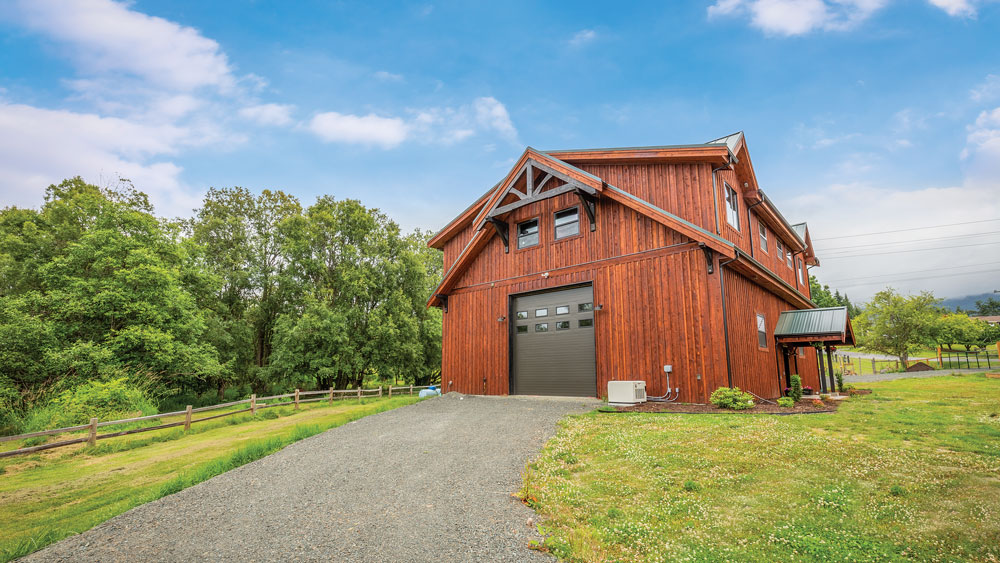








_11868_2023-04-24_12-34.jpg)
_11868_2023-04-24_12-34.jpg)
